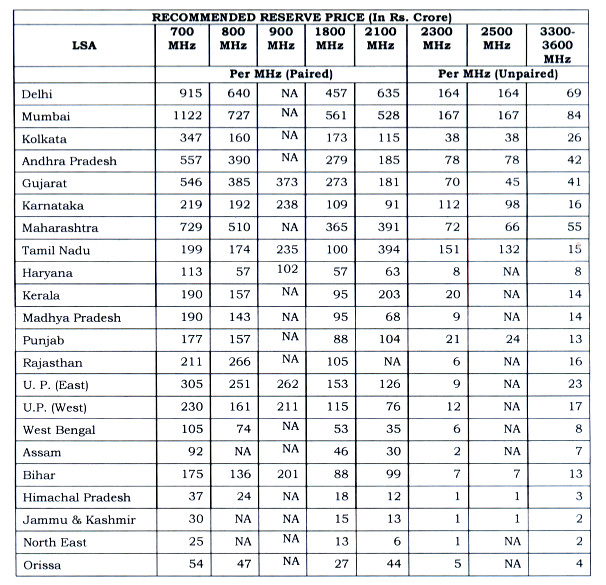
The Telecom Regulatory Authority of India (TRAI) just released recommendations on Auction of Spectrum in 700 MHz, 800 MHz, 900 MHz, 1800 MHz, 2100 MHz, 2300 MHz, 2500 MHz, including 5G spectrum – 3300-3400 MHz and 3400-3600 MHz bands after the Department of Telecommunications (DoT) requested TRAI to provide applicable reserve price, quantum of spectrum to be auctioned and associated conditions for auction of spectrum. This includes 3300-4200MHz bands, which likely to emerge as primary band for early 5G introduction.
In the last spectrum auction, held in October 2016, entire 770 MHz
in 700 MHz band, 58.75 MHz in 800 MHz band, 9.4 MHz in 900 MHz
3 band, 46.8 MHz in 1800 MHz band, 275 MHz in 2100 MHz band, 230
MHz (unpaired) in 2500 MHz band remained unsold, and the Government got bids worth Rs. 65,789 crore, less than their target.
As the result, the entire spectrum in 770 MHz band, 58.75 MHz spectrum in 19 circles, entire spectrum in 900 MHz band will be available in forthcoming auction.
BSNL has closed its CDMA services in 6 circles – Bihar, Haryana, Punjab, HP, UP (W) and Kolkata. In all these circles BSNL is holding 1.25 MHz administrative assigned spectrum in 800 MHz band, which was assigned for provision of CDMA services, so these spectrum may be taken back and put to auction in the forthcoming auction.
Aircel’s service licence in Tamil Nadu (incl. Chennai), is expiring in December 2018, so the spectrum in 900 MHz and 1800 MHz bands which it is holding that includes 7.8 MHz spectrum in Tamil Nadu (excluding Chennai) and 6.2 MHz spectrum in Chennai in 900 MHz band will be released. Therefore, 6.2 MHz in 900 MHz band will be put to auction in entire Tamil Nadu service area.
TRAI also released Recommended reserve price for various spectrum bands

TRAI said that some stakeholders said that the spectrum auction should
be held in 2019 when 5G technology is likely to be available for commercial launch in India, while one stakeholder suggested that for explosion of 4G services and advent of 5G, more spectrum is required and auction of spectrum should not be delayed. So it is not clear when the next auction will be held.
Spectrum recommendations:
- Entire available spectrum should be put to auction in the forthcoming
auction- Barring the specific locations or districts where ISRO is using the 25 MHz (3400 MHz – 3425 MHz) of spectrum, the entire spectrum from 3300 MHz to 3600 MHz should be made available for access services and should be included in the forthcoming auction
- 3300-3600 MHz should be auctioned as a single band and TDD based frequency arrangement should be adopted for this band.
- Spectrum in 3300-3600 MHz band should be put to auction in the block size of 20 MHz. To avoid monopolization of this band, there should be limit of 100 MHz per bidder. Since the TSPs are allowed to trade their partial or complete spectrum holding to another TSP, the limit of 100 MHz spectrum in 3300-3600 MHz band, shall also apply for spectrum trading. In case a TSP acquires more than one block, the entire spectrum should be assigned to it in contiguous form.
- No roll out obligations should be mandated for spectrum in 3300-3600 MHz band. However, to avoid any misuse of not mandating any roll-out obligations, the lock-in period for spectrum in this band for becoming eligible for spectrum trading should be 5 years instead of 2 years
- The revised provisions of spectrum cap (i.e. 35% Overall cap and a Cap of 50% on the combined spectrum holding in the sub-1 GHz bands) should be extended to 3300-3600 MHz band also. Additionally, in 3300-3600 MHz band, there should be a spectrum holding cap of 100 MHz per licensee
- There is an urgent need of audit for all allocated spectrum both commercial as well as spectrum allocated to various PSUs/ Government organizations. This should be done by an independent agency on a regular basis.
